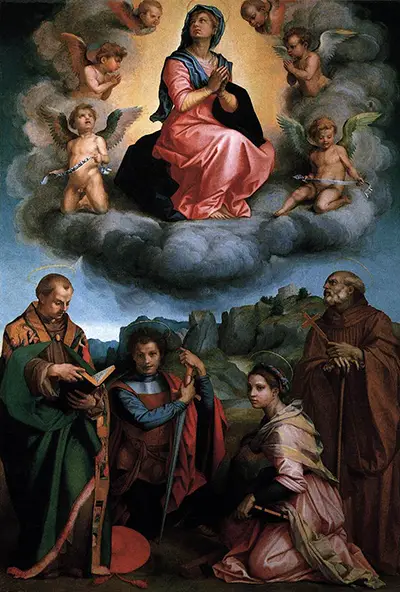Andrea del Sarto was a prominent artist in 16th century Florence and became most famous for his delicate frescoes and also some beautifully crafted drawings.
Introduction
This was an exciting artist who incorporated a warm palette of colours into some sublime portraits. He took inspiration from the likes of Da Vinci, plus also Fra Bartolommeo, a fellow Florentine. He would also look further afield, outside the boundaries of the Papal States, which was rare for Italian artists at that time. He was known to be an admirer of the Northern Renaissance and was intrigued by some of the variations in their work.
Early Training
Most documentation that we have suggests that he received his earliest training from Piero di Cosimo, who was a talented local artist who built up a solid reputation in his own right. At this time, there was a true abundance of artistic talent within the Florentine kingdom, with all of them competing for a relatively small supply of work. Therefore, self-promotion and a desire for continual improvement was essential to establishing one's financial future.
Mixture of Genres
Whilst skilled within portraiture, he was also famous for his work with altarpieces, such as Madonna of the Harpies, Assumption of the Virgin, Fathers Disputing on the Doctrine of the Trinity and also the Gambassi Altarpiece. Most were completed during the 1520s, by which time the artist was truly at the peak of his powers. There were also a number of smaller religiously-themed paintings which were perhaps intended for private devotion.
The wealth in Florence at the time meant that he had no need to go elsewhere for work, but he still chose to do so in order to expand the influences upon his work and also to satisfy his own curiosities about other cultures and other artists. Having sold some items to the French Kingdom, he travelled to France in 1518 after an invitation from François I.
Legacy
In terms of career legacy, Andrea del Sarto was unfortunate in two senses. Firstly, he arrived shortly after Michelangelo, Leonardo da Vinci and Raphael, and would always remain very much in their shadow, such as their own impact on Renaissance art as a whole.
Secondly, he died prematurely at the age of just 44, and this limited the amount of work that he was able to produce as well as cutting short his career just at the point that he would have been at his peak, both artistically but also in terms of the prominence of the commissions that he received. His demise was due to a bout of Bubonic Plague which was sweeping through Europe once more at the time. There was nothing that could be done for him, though his wife was at least able to avoid the same pitful and lived on for many decades.
Del Sarto, which translates from Italian as 'of tailor', referring to the occupation of his father, ran a successful studio for many years within Florence though none of those who would eventually have careers in their own rights would become particularly famous. There were others who were not part of his studio but can be considered followers of his, due to the similar styles in which they worked.
Influences and Related Artists
Jacopo Pontormo is certainly the best known of these, and he worked within the Mannerist movement of Florence until the mid-16th century. He was skilled in portraiture and handled colour particularly well, just as with his inspirational master. His work was eventually within a fairly independant style, though, despite some elements that can be compared with others. His travels and studies abroad helped to add to this element of uniqueness.
Giorgio Vasari would join Del Sarto's circle for his early training having been sent to Florence in his teens. He worked alongside fellow pupils such as Rosso Fiorentino and Jacopo Pontormo and learnt considerable technical skills during his time in this studio. He also became friends with Michelangelo and chose to take more of his style into his own than from anyone in his immediate circle.
He would later write critically about Andrea del Sarto, commenting on his excellent technical skills which, sadly, were not combined with quite the inspiring fire that some others had at that time. As a writer he was known to amend or embellish the truth, somewhat, so it is necessary to seek out alternative sources when studying his own views. Florence was very much the centre of the Renaissance during this period, and Del Sarto was still very much a prominent name at the time, only for it to quickly diminish due to the popularity of others.
Conclusion
Whilst we can argue that his reputation has been stunted by the popularity of the three great Renaissance masters, the fact that his remaining artworks reside in some of the most prestigious collections in the world underlines how there is still a great interest in his work. The Renaissance within Italy will likely never lose its status as the start of the types of art that we enjoy today and Del Sarto's original artworks can be found in some incredible collections, such as the National Gallery in London, the Museo del Prado in Madrid and, of course, the Uffizi in his home city of Florence.
Additionally, there is also the Museum of the Last Supper by Andrea del Sarto, also in Florence, which presents that original piece and also provides further information on this important, creative man. His work in his native city tend to be more likely on display than elsewhere, with institutions having thousands of items to choose between for a limited amount of space within their galleries and museums.




